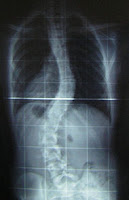Scoliosis Causes, Signs and Symptoms
Scoliosis
Scoliosis is a medical condition in which a person's spine is curved from side to side. Although it is a complex three-dimensional deformity, on an X-ray, viewed from the rear, the spine of an individual with scoliosis may look more like an "S" or a "C", rather than a straight line. Scoliosis is typically classified as either congenital (caused by vertebral anomalies present at birth), idiopathic (cause unknown, subclassified as infantile, juvenile, adolescent, or adult, according to when onset occurred), or neuromuscular (having developed as a secondary symptom of another condition, such as spina bifida, cerebral palsy, spinal muscular atrophy, or physical trauma). A lesser known underlying cause of scoliosis could be attributed to a condition called Chiari malformation.
Causes of Scoliosis
It has been estimated that approximately 65% of scoliosis cases are idiopathic, approximately 15% are congenital and approximately 10% are secondary to a neuromuscular disease.
Idiopathic scoliosis is a condition which lasts a lifetime, but it does not lower one's expected life span.
Adolescent idiopathic scoliosis has no clear causal agent and it is generally believed to be multifactorial, although genetics are believed to play a role. Various causes have been implicated, but none of them have consensus among scientists as the cause of scoliosis, though the role of genetic factors in the development of this condition is widely accepted. Still, at least one gene, notably CHD7, has been associated with the idiopathic form of scoliosis.
Congenital scoliosis can be traced to a malformation of the spine during weeks three to six in utero. It is a result of either a failure of formation, a failure of segmentation, or a combination of both.
Scoliosis secondary to neuromuscular disease may develop during adolescence, such as with tethered spinal cord syndrome. Scoliosis often presents itself, or worsens, during the adolescence growth spurt and is more often diagnosed in females versus males.
Signs and symptoms of Scoliosis
Patients having reached skeletal maturity are less likely to have a worsening case. Some severe cases of scoliosis can lead to diminishing lung capacity, putting pressure on the heart, and restricting physical activities.
The signs of scoliosis can include:
- Uneven musculature on one side of the spine
- A rib prominence and/or a prominent shoulder blade, caused by rotation of the ribcage in thoracic scoliosis
- Uneven hips, arms or leg lengths
- Slow nerve action (in some cases)

